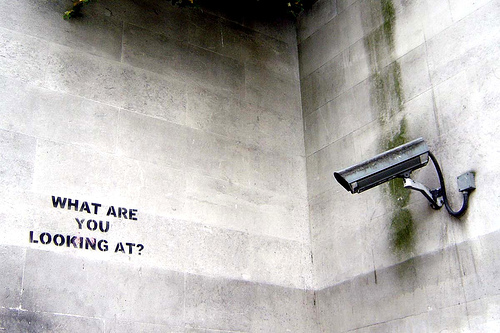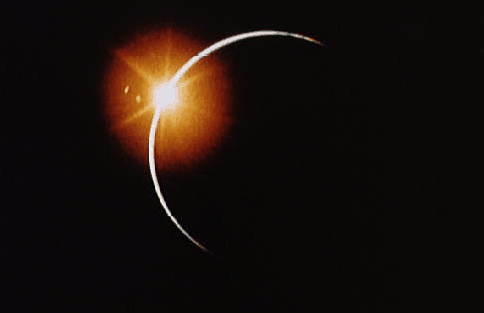sousveillance: a worm´s eyeview
The camera relieves us of the burden of memory. It surveys us like God, and it surveys for us.
-- John Berger in About Looking
What do you get when you inverse surveillance? A neologism: sousveillance.
For those of us who don't speak français as well as we ought, at least we can decipher that sousveillance is not describing the "traditional" perspective of an observer, i.e. someone perched sur (above) looking down. Instead, sousveillance is about the worm's eye view; it refers to observation rooted from sous (below) looking up. So while sur-veillance is a model for "top-down" observation (think burly authorities monitoring the streets from tinted control rooms), sous-veillance is an inversion of that standard structure, and it happens when the camera is directed away from the streets towards the tower.
The result? The observed become observers.

WHAT ARE YOU LOOKING AT? [photo of Bansky graffiti] by nolifebeforecoffee licensed under CC BY 2.0
By some interpretations, sousveillance is "watchful vigilance from underneath." It has the noble ring of camera-empowered citizens who by virtue of recording images, are able keep the higher-ups in check. The cameras, once distributed into the hands of dutiful civilians, are aimed at under-observed subjects: the police, military, public servants, the milkman, you name it, and any cheating or unlawful actions are brought to light.
Well, does this really happen when any camera carrying kid can record and observe anyone and anything? Are people taking pictures of the police? Geotagging security cameras? Video taping mistreatment by public officials? Yup. It turns out they are. And it turns out to be a really fascinating form of citizen participation.
Anecdote: When in Mumbai, I was told that the city was toughing up on obese policemen. As an incentive for the force to lose weight, the government was offering a cash reward to anyone who submitted a photo of a fat policeman. Motivated to do my part for society, I tried to take a picture of a rather big-boned copper. He won't let me.
~~~
Please don't get me wrong. All of this online participation is unquestionably useful and fun and enriching to our common digital culture. It is an invaluable way to share and build upon knowledge. No doubt about that. But I can't help imagine that as we approach total lifecasting, it could be that in the future, municipalities won't need to install security cameras. All of us will be pitching in already. We'll be streaming in family picnics and neighborhood snapshots into some grand searchable geotagged database. Then some upright netizens (us again) will comb the results for any noteworthy sightings. And once they're found, we'll go report them to the nearest overweight cop.
~~~
- Lifecasting on Wikipedia
- International Workshop on Inverse Surveillance [Joi Ito was on program committee]
- Tracking Transience Hasan M. Elahi's copious documentation of "20,000 images stretching back three years...posted copies of every debit card transaction, so you can see what he bought, where, and when...the perfect alibi."










0 Comments:
Post a Comment
<< Home